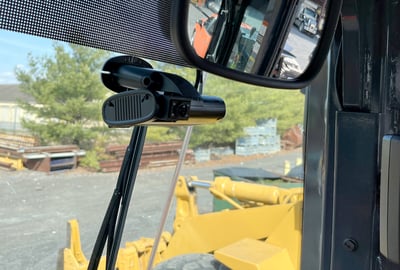
The construction industry is rapidly evolving, with technology driving innovation across job sites and fleet operations. One important advancement gaining popularity to help contractors manage vehicle and equipment fleets over recent years is video telematics. Video telematics in construction is part of a larger trend of using technology to improve safety, efficiency, and data-driven decision-making in the industry.
This article defines fleet video telematics and explores how this technology, powered by artificial intelligence (AI), can enhance safety, reduce risk, and deliver tangible value to construction businesses.
By knowing video telematics benefits and best practices, construction equipment fleet managers and safety professionals can leverage this technology as part of their holistic equipment fleet management program to transform their operations and protect their workers and business.
What is Video Telematics?
What is video telematics? Fleet video telematics is a technology that combines live video with telematics data to provide comprehensive insights into fleet operations. It integrates AI dash cameras and sensors with fleet management software to capture details like driver behavior, vehicle performance, and road conditions.
For construction fleets, video telematics means better visibility into the operations of trucks, heavy equipment, and other vehicles.
This technology includes features like:
- Driver and Operator Monitoring: Dash cameras record driver behavior, identifying distractions, fatigue, or unsafe actions.
- Event Analysis: AI dash cams detect incidents like hard braking, sudden acceleration, or collisions, triggering video capture for detailed analysis.
- GPS Integration: Combines location tracking with video for real-time insights.
- Data Storage and Reporting: Stores video footage and telematics data for later review and compliance documentation.
This technology has proven especially useful for industries like construction, where fleet safety and efficiency are paramount.
How Construction Businesses Use Fleet Video Telematics
Video telematics addresses critical challenges in construction fleet management. Below are some specific use cases tailored to contractors:
Enhancing Driver and Operator Safety with AI Dash Cams
Safety is a top priority for construction businesses, and video telematics directly contributes to safer performance and accident reduction. AI-enabled dash cameras watch and analyze driver behavior. They do this in real time or post processing, based on settings. Fleet dash cams can find problems like:
-
- Distracted driving (e.g., phone usage, eating while driving)
- Failure to wear seatbelts
- Aggressive driving, such as speeding or tailgating
By providing immediate feedback and training opportunities, operations and safety managers in construction businesses can proactively address unsafe behaviors before they escalate into accidents.
Incident Reconstruction with Video Footage
If a collision occurs, video telematics provides crucial evidence. Cameras capture the moments before, during, and after an event. They provide a clear and unbiased view of what occurred. This can:
-
- Protect drivers and businesses from false claims
- Expedite insurance claims processing
- Support legal defenses when necessary
For example, a contractor’s dump truck in a traffic accident could use telematics footage to show that the driver followed speed limits and drove safely. This could clear the driver of any blame.
Improving Job Site Safety with Video Telematics Systems
Fleet video telematics is not limited to vehicles — it can also be used for heavy equipment like excavators, bulldozers, and loaders. Monitoring operators ensures compliance with safety protocols, reduces misuse of machinery, and minimizes the risk of accidents caused by negligence or poor visibility.
Blind spots are common around construction equipment, and video telematics can offer a 360-degree view for the operator. This improves control and provides peace of mind for operators and can be pivotal in preventing struck by, caught-in or caught-between hazards.
Heavy equipment cameras are especially useful for construction businesses when working on projects on or around live traffic or in tight spaces. A construction worker is just as likely to be struck by a piece of construction equipment inside the work zone as by passing traffic in road construction work zones in the U.S, according to OSHA.
Reducing Fuel Consumption and Environmental Impact
Aggressive driving and idling are significant contributors to high fuel costs. Video telematics enables managers to track these behaviors and implement corrective measures, leading to:
-
- Reduced fuel consumption
- Lower emissions
- Decreased maintenance costs from wear and tear
When the video telematics tool is natively integrated within a total equipment management system, contractors can easily understand the inner and outer workings of their fleet, including equipment utilization, performance, and safety.
Training, Development and Culture
Recorded footage within video telematics systems offers a valuable resource for training drivers and operators. Real-world examples of good and bad practices help employees learn from actual scenarios, enhancing their skills and awareness.
Every project is unique, and conditions are constantly changing. Sharing videos of near misses, safe operation examples, and successes like winning lawsuits improves employee buy in. It also allows teams to develop new strategies for safety challenges and promotes a culture of safety in businesses.
Construction and Insurance Industry Collaboration
Insurance providers are increasingly recognizing the value of video telematics. Many brokers and carriers are partnering with telematics software companies to recommend vetted solutions for their construction clients. These partnerships aim to:
- Reduce claim frequency and severity
- Offer premium discounts to businesses implementing telematics programs
- Mitigate liability risks
For instance, contractors who adopt AI dash cameras might get lower insurance premiums as part of their risk management strategy. This trend reflects the growing emphasis on data-driven safety programs across the industry.
Benefits of Partnering with Construction-Focused Video Telematics Providers
Many fleet video telematics solutions are available, but not all fit the specific needs of construction businesses. Here’s why contractors should choose industry-specific providers:
- Understanding of Job Site Dynamics: Construction-focused providers create their solutions to meet the specific needs of job sites, in addition to the overall nuances of the construction industry.
- Specialized Products: These providers offer tools and features for tracking and monitoring a construction fleet, ensuring safety compliance alongside utilization, inspections, maintenance and more within a single software designed for construction equipment management.
- Tailored Support: Providers who know the construction industry understand the workflows and pain points of construction teams. They offer customized training and ongoing support. This is a significant advantage over providers who do not focus on the industry.
Rolling Out Video Telematics in Your Construction Fleet
To maximize the benefits of fleet video telematics, a thoughtful implementation strategy is essential. Below are some best practices:
.gif?width=75&height=75&name=1-VEED%20(1).gif) Secure Buy-In from Stakeholders
Secure Buy-In from Stakeholders
Involve key stakeholders at all stages. This includes executive leaders, fleet managers, safety officers, and drivers or operators. Communicate the benefits of the technology, emphasizing how it enhances safety and efficiency rather than surveilling employees.
Roll Out Video Telematics Solutions in Phases
Like all construction projects, starting with a clear project plan and schedule is a smart way to start the implementation journey. Begin with a step-by-step implementation to fully understand the technology and gather feedback at a manageable scale. Use the initial phases to improve how you review and use data. This will help show the value to the broader team.
Comprehensive Training by Fleet Managers
Ensure all users understand how to operate the technology and interpret the data. Training should cover:
-
-
-
- How dash cameras work
- Reviewing footage and reports
- Incorporating insights into daily operations
- How video telematics fits within the overall safety program
-
-
Integrate with Construction Safety Programs
Use video telematics data to enhance your existing safety initiatives. For example:
-
-
-
- Conduct regular safety meetings to review video footage and discuss lessons learned.
- Recognize and reward safe driving behaviors.
- Address recurring issues with targeted training sessions.
- Share wins as well as watch-outs
- Continuously monitor performance and adapt policies, protocols and strategies according to insights.
-
-
Learn more about video telematics systems
that are best for construction
Learn More
The Impact of Video Telematics on the Construction Industry
Video telematics is more than just a fleet management tool—it’s a complete solution for improving safety, reducing risk, and optimizing operations. By leveraging AI-powered video telematics for construction safety, contractors can unlock unparalleled visibility into their fleet operations.
Additionally, by partnering with a provider who knows the construction industry, contractors can achieve significant benefits, including lower insurance premiums, better job site safety, and a stronger safety culture.
With AI-powered capabilities, fleet video telematics offers actionable insights that empower fleet managers and safety professionals to make data-driven decisions. As this technology continues to evolve, it will become a key part of every construction business’s toolkit.
About Geoffrey Rodgers
Geoffrey has over 20 years of experience in software engineering with 10 years of experience working with edge technology like RFID, Bluetooth Low Energy, and vehicle telematics. As a product owner holding degrees in Computer Science and Business Administration, Geoffrey seeks to understand and translate market needs into clearly defined requirements for engineering teams and ensure the organization is directionally aligned.



.gif?width=75&height=75&name=2-VEED%20(1).gif)

